The velvet jacket and modern evening wear, in Cifonelli
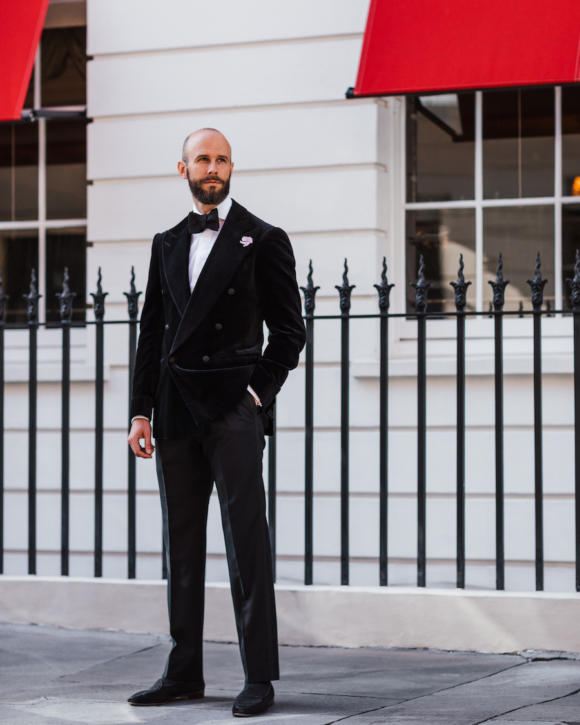
This article concerns two things.
First, the pluses and minuses of the Cifonelli 6x1 style, as this is the first jacket I’ve had from them in their well-known cut.
And second, the benefits of a velvet jacket without silk facings - and how it can create a more versatile jacket covering both black tie and other evening events.
Looking at the 6x1 first: this is a style of double-breasted jacket with the standard six buttons on the front, but where the lapel fastens on the bottom row.
Compared to the more usual style, where the lapel fastens on the middle row, this means the lapel is longer, usually wider at the top, and as a result more dramatic.
Cifonelli are not the only tailor to cut this style, but it is one they are known for.
I’ve generally not chosen it in the past because I felt it was too showy, and dandy. I've had two jackets in a standard buttoning instead - a grey herringbone in 2013 and a denim in 2017.
But I always said the style would be best in a show piece, such as a dinner jacket or velvet. And so that’s what I went with in this commission.
The result is, of course, absolutely exquisite. No details or review are needed of the workmanship of Cifonelli. It is the equal of any in the world.
[If you want more information or background, there are several years of coverage, visits, detail and review under the ‘Cifonelli’ label under Brands.]
I did have a few issues with the fitting with Lorenzo, basically in getting the shoulders large enough. Everything else was nailed first time, but it took a little back and forth for me to feel there was enough room there.
Aside from the button fastening and the lapel facings (which we’ll get to later), the design of the jacket was pretty classic.
Jetted pockets, turn-back cuffs, two vents (I generally dislike ventless jackets, as I like to use my trouser pockets), and grosgrain-covered buttons.
The trousers are in a lightweight wool, with grosgrain running down the seams and on the waistband (I’ll try and take some pictures of those later).
So does the 6x1 work?
Well, having one of my own and wearing it a few times, has I think borne out my thoughts on it.
Which is that it is certainly dramatic, and has real pluses and minuses.
The drama of the lapel means I don’t think this would ever be suitable for a business suit or a casual jacket. Show piece feels like the right phrase.
But it definitely has advantages. It opens up the chest, creates a long diagonal line (not dissimilar to a military sash) and throws the eye up towards the shoulders.
On the downside, it makes the bottom of the jacket - below the fastened button - very shortened. There is no shape or flow to the skirt.
This is not a problem when using the trouser pockets, moving, or standing in some way that opens the bottom of the jacket. But when still, you do notice that lack.
I think it still flatters me, but I also think it perhaps flatters shorter men more - who are more in need of that length to the lapel, and more prepared to lose the shape in the skirt.
Another small disadvantage, which didn’t occur to me in advance, is that the breast pocket is almost entirely covered by the lapel, making it impossible to wear a pocket handkerchief.
Now for that style point: the lack of silk facings.
All dinner jackets, and most velvet jackets, have a different texture on the facings, showing on the outside on the lapels.
It’s normally satin or silk grosgrain, with the latter the better choice (satin is cheaper and can look cheap).
However, the disadvantage of this style is that it can restrict the jacket to black-tie events. These have an admirably narrow dress code, which creates a pleasing, communal elegance (please, no showy bow ties or cummerbunds).
The idea with this jacket was that it would be still wearable as black tie (below), but could also be a little more casual, for a dinner party this time of year, for example.
This is particularly interesting theme, for me, because men are increasingly wearing tailoring for these kind of evening events, rather than to the office.
It’s smart evening wear, rather than smart day wear.
We touched on this topic in our recent talk with Saman Amel. They find in Sweden that customers might wear streetwear during the day, but still want to be dressed up for a party in the evening.
That might mean they commission a black-linen suit from Saman Amel, and wear it with a black T-shirt.
I wouldn’t wear that combination personally, but it follows the basic principles of evening wear: to dress simply in dark tonal combinations, with an emphasis on cut and texture.
With this Cifonelli jacket, then, I would wear it as black tie but also with a white open-neck shirt (above), or with a dark roll neck.
This velvet with a charcoal roll neck, and cream trousers, would look extremely elegant. But it certainly wouldn’t be black tie.
Equally, a white open-neck shirt with pale-grey flannel trousers is certainly not formal, but still looks very elegant.
The shirt I’m wearing here is perhaps not a great example: the collar works fine with the bow tie, but is a little low to function on its own. I’d prefer something a little stiffer and higher.
But hopefully the principle comes across. Again, I’ll take shots at some point of me in the roll neck combination too.
That shirt is from D’Avino. It's a style of shirt I like for black tie: a superfine cotton with no Marcella or pleats, just a covered placket. It also means it can be worn with a regular necktie too.
The slippers are from Baudoin & Lange, in alligator and suede. Which I like but feel that, on reflection, the black-tie outfit could do with a little more shine. Having that contrast with the trousers would be nice.
The bow tie is also from Cifonelli, in grosgrain to match the buttons. I usually wear a thinner bow with a tighter knot, but don’t mind this looser, chunkier one with the velvet.
The cream trousers are in wool gabardine - old ones from Anderson & Sheppard. Beautiful but rarely worn.
The boutonniere was from a flower bed nearby. I do love a flower when I get a chance to wear one. Just like the fancy silk of a necktie, it's the kind of decoration men should grab the opportunity to wear when they can.
Photography: Milad Abedi @milad_abedi
Price of velvet Cifonelli jacket in this style: €5500


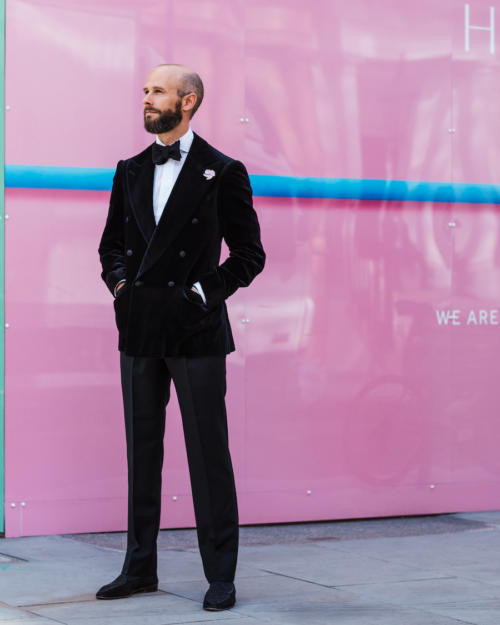
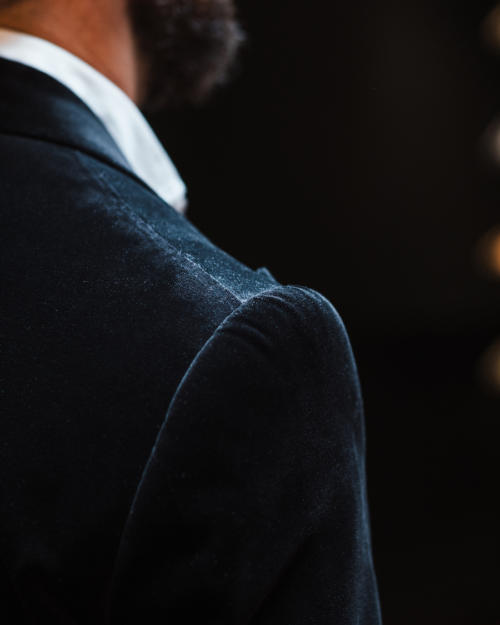
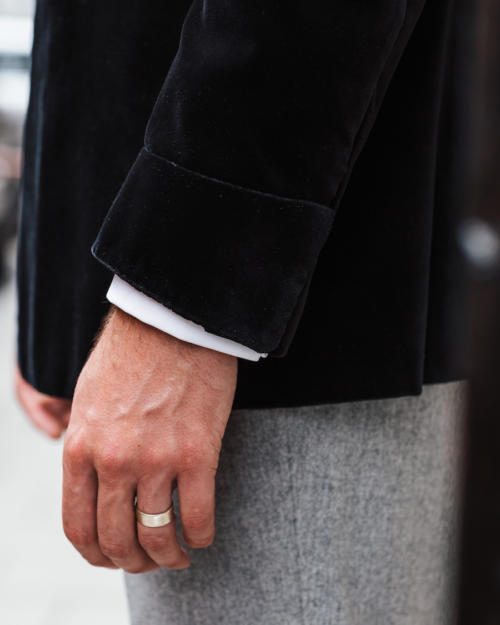
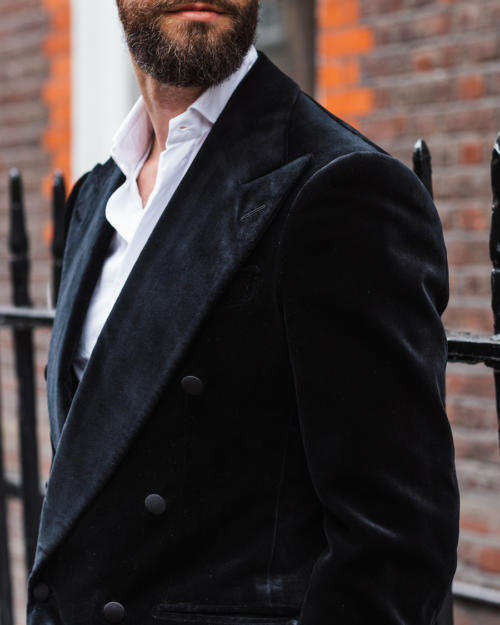
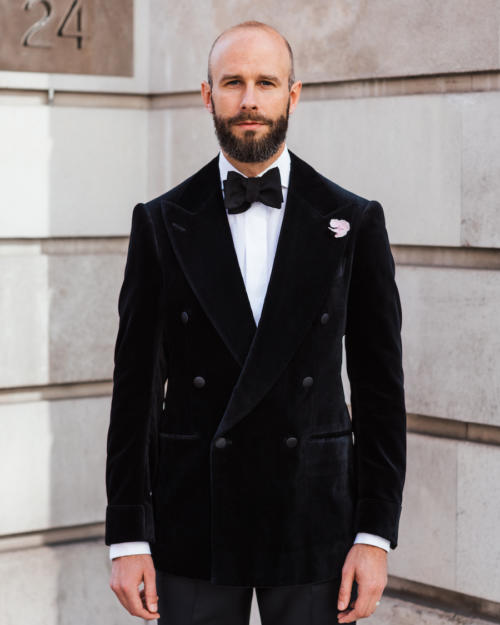
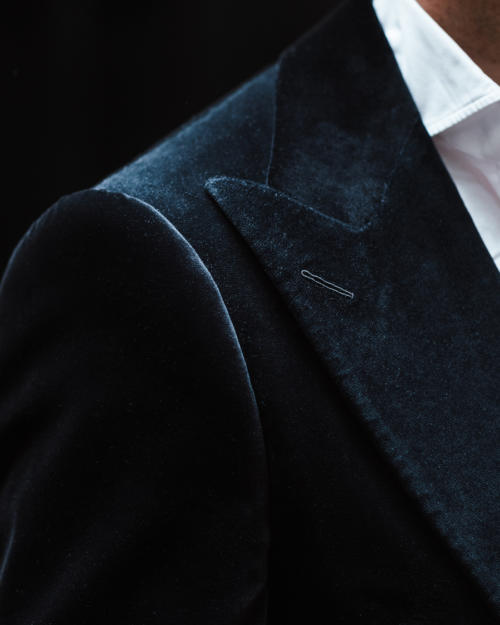
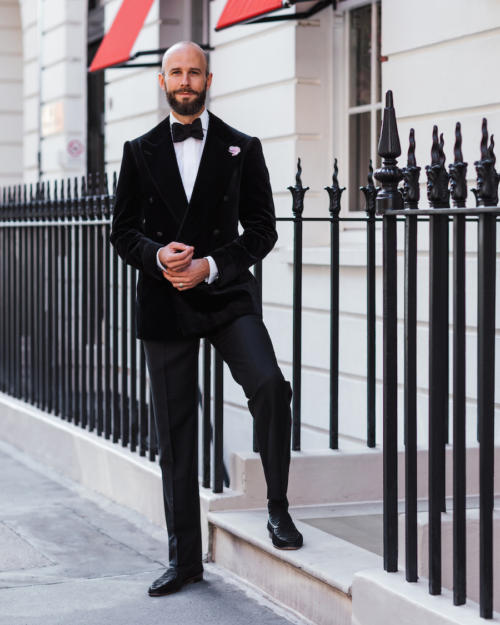
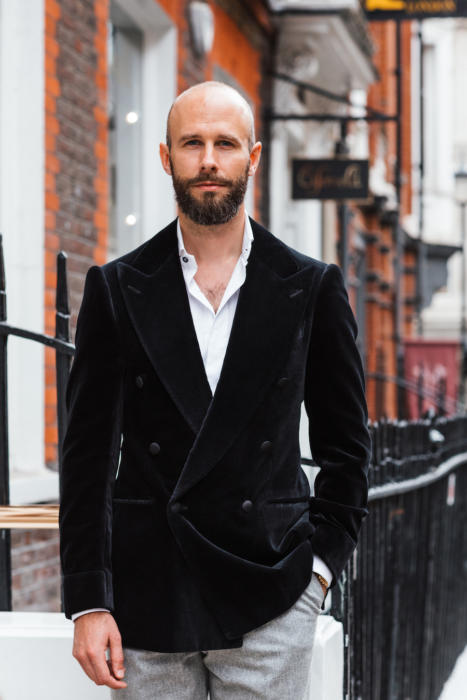
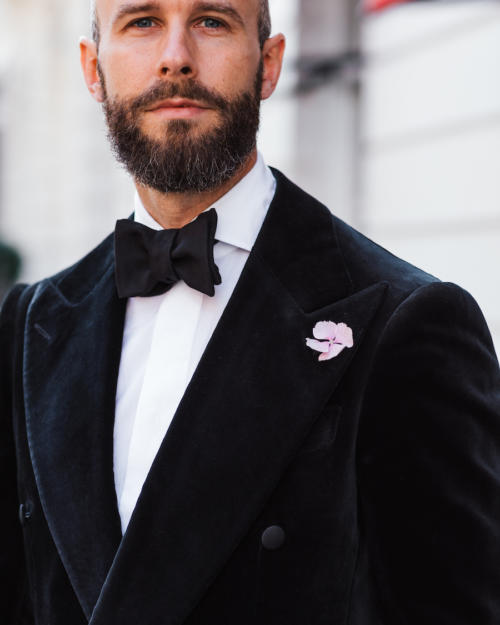
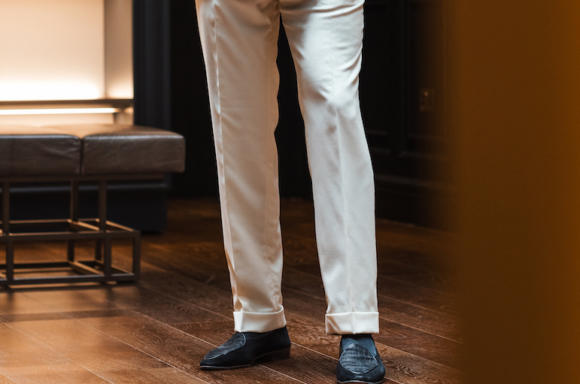
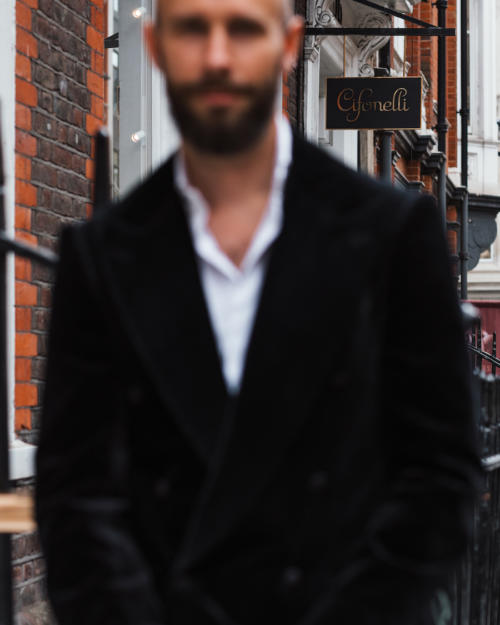


























I love the self-facing look with velvet. I sometimes wish I’d had this on my Poole smoking jacket. One thing I have learnt after 5 years of regular wear is velvet is fragile! I used to put my hands in the jacket pocket – until they ripped (magically repaired by HP) so I went to putting my hands in the trouser pockets and now notice the hem of the jacket is beginning to fray in places. It’s lovely material but handle with care!
Edward,
It could simply be the velvet. What weight of velvet did you use? Was it pure silk velvet? I have my Father’s silk velvet sport coat from the 1970s (mercifully he disdained the worst of that decade’s sartorial proclivities), and it has held up gorgeously, even with regular wear! It is made up in black, pure, silk velvet of about 16 oz. or so; very robust, very plush, but also firm; as firm nearly, as Melton wool, but much softer. The velvet is also extremely densely woven, which sadly, most modern velvets are not. As it is more of a jacket for special occasions, I echoed my Father when I had it re-lined about 15 years ago, and had it re-lined in vintage blood red silk satin of a very high quality.
The weight and density of weave, and material out of which yr yardage was woven make all of the difference in velvet.
For anyone who’s interested, the velvet jacket also has smoky black with hints of blue, pink and red abalone buttons with Milanese stitching on the cuff buttons, it is single breasted, notched lapelled, 2 buttoned, and has a single vent, with slightly structured shoulders and high arm holes and patched hip pockets and a welted breast pocket.
Very nice jacket.
I’m intrigued by the velvet. Would this ensemble be proper for a wedding suit, or would the velvet make it too showy?
As with most weddings today, it depends entirely on the host and what they specify. But if it said black tie, no I’d go for something more conservative if I had the choice
Beautiful jacket. Curious about your choice of buttons, why didn’t you go with self (velvet) covered buttons? It seems the grosgrain is fine when wearing a matching bow tie and or trouser braids, to give it context. When the jacket is worn on it’s own however, they seem out of place, or orphaned from another ensemble. Thanks
Interesting point. I did look at velvet, but the grosgrain seemed like a nice, very small detail. Almost unnoticeable
Does the jacket look sharper in person Simon?
Could you expand a bit? What do you mean by sharper more exactly?
My comment wasn’t a criticism and I mean no offence.
You know what, I think I’m just used to seeing Dinner Jackets in Wool, Wool & Mohair or Pure Silk which tends to look crisper and subsequently, to my eye at least sharper.
The MB coat you posted a few weeks ago looks ‘sharp’ The Vestrucci Suit you posted last week looks ‘sharp’ even the denim DB you had made by them looks ‘sharp’
Perhaps it’s the 6×1 configuration on someone taller than 5’5” I don’t know..
Lovely piece beautifully made enjoy
Not at all, none taken. Just interested in what you meant.
Perhaps it might be velvet as well, which always has that softness to it.
A very interesting article and garment. While I tend more towards early-period black tie, I think a lot of fellows could use this sort of jacket as a “very smart without being proper black tie” alternative. I’ve used a plain SB navy velvet jacket for such evenings in the past but I like that DB effect!
Hi Simon
Great post. I get your ‘show piece’ observation, but I must disagree with it.
I have four Cifonelli 6×1 suits, and amongst others, they are part of my daily work rotation. It’s worth pointing out that I have never received any negative feedback or felt awkward wearing them, no matter the meeting nor the country. Quite the contrary actually. Every time I wear one of them, I feel that inexplicable boost of confidence, as if nothing will get me down that day. Strange thing how a suit can evoke said emotion, but its there nonetheless.
Thanks Lucas, very interesting. What industry do you work in, if you don’t mind me asking?
I work in a boutique investment house in Mayfair. Typical day could involve meeting with fellow fund managers, lawyers, employees from target investment companies, etc, but also after work drinks with friends and family…
Whilst very much a structured proposal, Cifonelli’s 6×1 may very well break with the archetypal navy worsted SB people often associate when thinking about a suit, so they go along with it welcoming something different…
Thanks Lucas
I work in the city and, to be perfectly honest, I don’t think the majority of people would notice the difference between a 6×2, a 4×1 or 6×1. I genuinely believe that some people might not even notice that the suit is double breasted.
If I were going to order a suit from Cifonelli then I would be tempted to order a 6×1 in a conservative fabric and have it as part of my work wardrobe. Of course, the fact that I’ve never acquired a double breasted suit suggests that I’d be far more likely to just think about it for 4-10 months and then get another single breasted suit.
The reason for this is simple: double breasted suits are rarities and I don’t think I’d want to wear one very often (mostly because I think most people would notice and find it odd but partly because it doesn’t seem to work as well when seated). A debate about 6×1 versus 6×2 would be driven (for me) almost exclusively by what I think would look better and very little about the level of formality involved or whether a style is more dramatic .
The reality is that most people just see a suit. I’ve spoken to colleagues with non-standard stylistic choices (e.g. patch pockets or peak lapels on a single breasted jacket) and they had not noticed that the suit they were wearing had those features.
In my experience, the reality is that “formal enough” is covered 99% of the time by wearing a suit but that doesn’t make thinking about these points less satisfying. I wear a suit to client meetings to avoid any negative perception but beyond that I largely make stylistic choices for myself alone (although I do stick to the more colours discussed in the business suit capsule wardrobe article, as I think most people do notice that – although it also suits my eye and tie collection).
Hi Michael,
But, isnt that what we all strive to accomplish really, just looking elegant without people knowing why? Of course we make our own stylistic or functional choices (I agree that a DB doesnt work as well with sitting down) and that is the fun in it. But the cleanliness and cut of a bespoke suit is what makes people think we look elegant and refined, instead of showy and “dandy”.
Very good point, yes. And in the same way, people may well think someone looks scruffy, or well dressed, or showy, or a bit old fashioned, without accurately being able to put a finger on why.
Nicholas, many thanks for your response. I do not believe we are disagreeing in broad terms. I am saying that the majority of people I meet in the city would reach that view because a suit is double breasted. I do not think 6×1 or 6×2 would be a significant factor because the suit is, in their minds, already very “showy” or “dandy” by virtue of being double breasted.
I frequently see comments suggesting that fabrics or stylistic features might not be suitable for work in the city and in the vast majority of instances it is simply not the case (e.g. I seem to recall comments urging somebody to spurn flannel or patch pockets for fear of being too informal). If somebody wears a well fitting suit in a conservative colour they will be more formally dressed than the vast majority of people in the room. Any perception caused by the feature is overwhelmed by the fact that the suit fits well and has a flattering cut.
To put this into perspective, Simon instigated the tailoring guide to help readers understand the differences between tailoring houses and styles. Permanent Style recently did videos to try and illustrate the differences between Neapolitan and English tailoring styles. If tailoring enthusiasts benefit from this much assistance in appreciating the differences then how much harder will people who have little to no interest in tailoring find it (and thus how much smaller the overall difference appears to them).
My point isn’t that the differences are irrelevant or that we should all wear colours that would make a peacock blush – it is that we have a broader range to decide how we express ourselves in tailoring choices than we initially think when we absorb the information on websites like Permanent Style. If Lucas finds a 6×1 suits him and he prefers the style then I would not urge him to instead wear a 6×2 because how how colleagues will perceive him. I find it odd that so many tailoring enthusiasts both bemoan the decline in standards yet also believe co-workers have their opinion (consciously or unconsciously) materially affected by a suit having unused patch pockets versus flap pockets… or in this instance by the button stance being 6×1 or 6×2.
The small differences still matter to me, but because they matter to me not because I believe they matter to people I work with. If I had Simon’s lifestyle and spent most of my time talking with people who work in tailoring or are passionate about it then my view would likely be different.
Hi Michael
I have to agree with you. I am a tailoring enthusiast – I have tried around 15 bespoke tailors in the past five years or so. But whilst I am very interested in the ‘sartorial path’, developing preferences for stylistic nuances (ie. lapel types, gorge heights, belly vs no belly etc), for the vast majority of people, a suit is just a suit.
Take my father for instance. He has worn a suit every day to work for the past 40 years or so. If you ask him the difference between 6×1 and 6×2, he would be clueless. Not because he does not like clothes, but because he has not developed a taste for the little things within the tailoring domain.
And Nicolas, as a side note, if you do not like the 6×1 sitting down (I share that view to some extent), just unfasten it and be casual about it.
To chip in briefly, I do think it’s been the case through most of the past 100 years that most men didn’t look at these differences, or care a lot about them. But the general standard of taste and norm on spending on clothes was different. Men saw well-dressed men everywhere about them, and followed suit. And people did buy more expensive clothes, but fewer of them. And not necessarily spend more money overall as a result.
Dear Simon,
This is a lovely example of Cifonelli tailoring.
This velvet jacket very suitable for their style and level of detailing. I would definitely consider it even though Cifonelli is not a house which is very close to my taste typically due to the shoulder.
Cheers,
Alex N.
Great piece. Love the velvet jacket. and the theme generally. I have a similar jacket, single breasted but with similar wide peaked lapels with belly (although I can just manage a hint of handkerchief). Incidentally I think it looks rather good with black jeans (properly black and undistressed), for not-black tie eveningwear- would you and could you with the DB velvet?
The 6 x1 is a whole different issue and I share your thought on it for business attire, although perhaps for different reasons: I can’t help thinking of early 90s politicians, but that’s perhaps age-specific and I should get over it. I note that the Parisian Gentlemen wears little else. It looks great on your velvet jacket though.
Hey Simon,
I do find this trend of people trying to “deformalise” formal wear quite interesting, and I think there are certaing things that look amazing, like a rollneck with a velvet suit for instance, very mature and elegant. But seeing this lovely Cifonelli jacket with an open neck shirt (or worse if someone were to use a t-shirt) there is just something off-putting about it. In my humble opinion the open neck shirt look is best used with an italian sport coat and a pair of nice odd trousers. Both complementing and functional (in warmer climates). If it were single-breasted it might have worked a bit more, but still I find that formal wear work best when they retain the elements of formality, such as not showing unneccessary skin.
A velvet suit? I like the idea but the trousers would be short lived no?
Hi Simon, Interesting post and feels fitting for this time of year. I have two observations on reading this article. I have never really been a fan of the 6×1 style partly for the reasons you have identified [short skirt etc]. However I disagree that it cant be worn more casually. Luca Rubinacci wears a 6×1 regularly, indeed it appears to be a Rubinacci staple, and he does so very often in a casual manner.
Secondly, I have to say I am not a fan of the contrast shirt button shown on the ‘open neck’ picture. I appreciate that black buttons may appear on a white shirt for black tie occasions but in this case it reminds of the rather over designed and brash shirts some football pundits [Mark Lawrenson] are prone to wear.
Yes, good point on the black mother-of-pearl button. I had forgotten it was there until I took the bow tie off…
I really don’t like the 6×1 buttoning configuration in general (somehow it just harks back to the 80s in a really bad way) but somehow this one works for me, perhaps it’s the texture of velvet that makes a difference, come to think of it would probably work with corduroy as well. I see buttons have been mentioned already, I would have personally gone simply for black polished horn, like the ones RL has recently been putting on his DJs, think it would make it more versatile, but tbh recently I just like the look of it more and more, even on standard DJs. Also, I think the collar is a bit too cutaway to be worn with a bow tie, makes it look a bit like the bow is slightly separate from the rest of the outfit.
Would be interesting to hear more about the issues with the shoulder, as given that you have had a number of things made by Cifonelli I would have assumed these things wouldn’t be popping up. Finally, had another beret moment with the flower! Absolutely love it and somehow I feel like this is something that I will actually incorporate occasionally into my outfits, unlike, perhaps, the beret.
Absolutely stunning! I have to say that you really know how to adapt your style for different situations, I especially like the less formal style you mention. Personally, I have never been invited to any black-tie events and I doubt I will be in the future, but I could still very much imagine myself wearing something like this for a fancy dinner.
I am fairly new to this level of sartorial craftmanship and I was wondering if you could clarify a few things for me based on your new suit.
first of, what colour is this? I find it hard to identify the different shades of dark blue/black velvet due to how it changes in the light.
Secondly, I have heard mention of “the three silhouettes”. I dont know which those are, but I dont think I have ever seen you in a suit with the same cut as this. is this a unique cut to Cifonelli or do you see other tailors doing the same? thanks!
Thanks.
It’s black velvet.
I’m not sure what you are referring to with the three silhouettes – perhaps you could link to where you saw that? As mentioned in the piece, this design of double-breasted jacket, which buttons low on the body, is not unique to Cifonelli but they are known for it. They also do it in slightly their own way, for example by cutting the lapel separately in order to get more curve on the shape.
The 3 silhouettes are American, English, and Italian, more or less. There are others, but they are typically, or were typically, traditionally, modifications upon these 3 basic types. The French also had a “national” silhouettes, leaning towards much more structure and heavier shoulder treatments such as built up shoulders and heavy roping. At least according to the old tailoring books which I’ve perused.
Interesting. Seems a little US-centric perhaps. There are more variations between north and south Italy than with most things and the US
I’d agree, Simon, mostly. The books which I’ve read through on the subject, granted, were largely written in the 1950s and 1960s or earlier, so there is also that to consider. But my comment was in response to the other fellow’s remark about the 3 “silhouettes”, and that is a (notably dated), but poignant reference to that old perspective on the 3 dominant regions of tailoring. It is rather US centric, and amusing as the American silhouette is basically the pre-WWI, that is to say Edwardian British silhouette. Always a pleasure!
What does that mean “6*1 suit”?
Sorry for my ignorance!
I explain it in the fourth paragraph – did you see that?
Hi Simon
what a spectacular jacket. I really think the 6×1 cut is fantastic. Shortening the jacket to the eye gives the overall look a much more modern feel and enhances the upper which I find highly recommended, as long as it does not alter too much the proportion of the body. Seeing the relationship between cut and fabric/pattern, it raises a doubt. Formal cut jackets (peak lapels, one button, structured shoulders, strong padding) in more casual fabrics such as those used in summer or not very formal patterns. In those cases I have doubts as to how versatile those jackets can be. I mean, how formal styles of jackets clashes with less formal fabrics. They are usually very attractive in the rack, but I have many doubts of their usefulness.
In your opinion, which element is more important on the scale of formality, cutting/style or fabric/pattern used ?
Thanks a lot.
Dan.
They’re all important Dan, and have an impact, but the fabric is likely to have a slightly larger one. Probably colour, followed by pattern, followed by texture.
Coincidentally I’ve been thinking of getting a velvet jacket, to do double duty in much the same way.
Lots of people have recommended to go with either shawl collars or single button peak lapel, but I find the former too much of a smoking jacket and the latter a bit jarring. Which leaves me with either SB notch lapel (too informal I think) or double breasted as you’ve done here. I think DB is the way to go and would imagine you agree?
Would you have the fabric reference by chance?
Of those options, yes I would.
On the cloth, just go for black velvet. It doesn’t vary much and you’ll want to make your own decision as regards weight.
I was originally thinking navy, or maybe grey, velvet but I have to admit the black looks amazing.
Might I suggest a deepest maroon velvet jacket, single or double breasted, with soft shoulders and a fish mount lapel? If you have it made up with abalone or dark mother of pearl buttons it would be very handsome. I’d also say with velvet, less is more, so if its single breasted, one button fastening, or DB, still one button fastening, but perhaps others for decoration. Good luck on yr soon to be commission!
Apparently, I posted my reply in the wrong section! This was for Peter, immediately above!
Simon, Your comment that the 6*1 model makes the skirt look short and is more appropriate for shorter men is quite right. To my eye, the jacket looks unbalanced because of that short skirt. Love the fabric, but a 6*2 model would look much better on you.
Hi Simon, excellent jacket. I have been wearing a midnight blue double breasted RTW woollen dinner jacket (from a fashion brand that I happened to stumble upon) for fancy but non-black tie evening events for a while now – with white trousers mostly – and I think it works very well. One question: I am surprised by the turn-back cuffs. I am not used to seeing those on dinner jackets and would not expect them (as cuffs are informal) – are they inspired by the original smoking jackets? Or why are they there? Many thanks
Interestingly, they aren’t seen as less formal, no. It’s not that uncommon for black tie to have them, and certainly smoking jackets. On the one side, it does interrupt the clean line of the sleeve, which might be less formal. On the other, it means the end of the sleeve finishes in a turn of material, like a double-cuffed shirt
Nice. I think I like it best with the lighter coloured trousers.
As someone who doesn’t attend many (read: any) black tie events, I’m not sure how common velvet jackets are in such surroundings. Are they always considered acceptable?
Not always, and if you were attending a formal event it might be best to check with the host. But most black tie events are not that disciplined these days and you often see a smattering of velvet. Often a bit too showy or strong in colour though
Beautiful jacket, Simon. Excellent choice to go with the 6×1 configuration. I think the jacket will work perfectly well in the double duty manner that you describe. Having it self-faced, I think, is the key. Doing so doesn’t compromise its identify as a dinner jacket but does mean it can make that transition to cocktail wear. Indeed, I just obtained a cream “cocktail jacket” from Edward Sexton that I realized can perform in the same way, but in reverse: it’s more of a day/afternoon wear piece but can double as a dinner jacket on occasion. It’s sort of the inverse of your black velvet jacket. I’ve also noticed the same “issue” with Sexton’s lapels that you mention with Cifonelli, namely they are so wide that they virtually cover the breast pocket. So, I substitute a boutonnière whenever possible. Anyway, black velvet is a classic and I think it will serve you well. I like your bow tie, too.
Thanks Andy, and interesting point on the double use of the cream jacket as well
Simon, I’ve been wearing a single-breasted black velvet jacket for about fifteen years that is probably the most versatile piece of clothing that I own. On the most basic level I wear it with a white open-neck shirt and jeans, to add a touch of rakish elegance to everyday wear. Most of the time I pair it with charcoal grey flannel trousers (or something lighter in summer), with or without a tie (usually in the grey range, though something festive works, too), when a suit is too formal, but a tweed jacket is too casual. I have on occasion worn it with tuxedo trousers and a black bow tie. For more elegant evening occasions it is often partnered, usually without a tie, with a waistcoat my tailor made me from blue and red Liberty “Ianthe” satin, for which the black velvet is a perfect foil. And about once a year, for the most rare occasions, where a tuxedo is too much but a suit is too little, it gets paired with a matching pair of black velvet trousers. Because it is so versatile I frequently choose it for travel, as it can obviate the need to pack a suit at all.
Hi Simon,
Stunning jacket! Many thanks for the post, I’ve been waiting for it after asking about a more flexible velvet dinner jacket.
Some brief questions:
– Would single breasted with peaks be more versatile? That is easier to wear outside black tie.
– What about having flap pockets that can de tucked in so they appear jetted, would that work?
– For a single breasted jacket would a single button work for more casual occasions?
– Finally, how fragile is velvet? Is this a heavy fabric?
Hi Noel,
– Yes, a peak SB would be as versatile, though you’d then need something to cover the waist when wearing black tie
– Yes, flaps that tuck in would be good.
– Probably, yes
– Velvet is fine I think for dress wear like this. I wouldn’t have it for an everyday piece, but this will get fairly light wear
Hi, if you would own only one flannel suit, what would you recommend? A mid grey or a charcoal?
Mid-grey, unless I worked in a formal business environment and would wear black shoes and a tie most of the time with it
Ciao Simon . I think that the real master of 6×1 is Mimmo Pirozzi via Chiaia.
I agree with you that this style is great for shorter men (of which I am one.) I’ve tried the more traditional DB buttoning styles and I just wasn’t comfortable with the look. But the 6×1 really suits me. I wouldn’t do it for a majority of my suits but once in a while it’s nice.
I also agree that it’s best with a fabric that doesn’t scream conservative business suit. My favorite 6×1 is a grey flannel glen plaid. The fabric matches well with the 6×1 buttoning stance.
It’s a striking piece in content and form but I’ll be interested to know how it is used in the future. I had something similar in SB and was able to use it in a number of ways as you allude to. However as it was simple and softer in cut, with regular, not covered, buttons, it could make the transition to more informal use.
The Cifonelli is a stand-out, eye catching piece, expressive of the tailors art and has an almost military aspect to it: perhaps due to the 6:1, short length (lack of visual waist), and pronounced shoulders it somewhat leans towards a Spencer Mess jacket.
https://www.pinterest.com/pin/390476230169887507/
Because of this, it will not easily transition into informal situations: if it were more louche, softer in shoulder, simpler in construction it might work but given the athleisure environment a la mode I can’t see this gelling – even if the buttons were changed (covered buttons are always formal).
Reflecting upon Nicolas Stromback’s comments and the other reference to Rubinacci I wonder whether, to allay the overtly formal design, another colour choice, perhaps dark green or midnight blue, might have softened this association: still acceptable for evening wear but a step away from ever-formal black (were you in warmer climes I might even suggest ecru/cream).
Ultimately, as an exceptional piece of evening dress, it is outstanding but it is a misconception to theoretically apply its formal architecture to more relaxed environs as it will stand out and, against good PS practice, other guests might see the jacket first and not the man? Perhaps, if fashion moves back to a more formal and sophisticated setting, the jacket’s cut and stance will feel more organic to this new mode?
Separately, could you give some detail re. the well cut formal trousers – you mention the A&S ones but skip the formal.
N.B. I think the ‘three silhouettes’ referred to earlier are English/American/Italian?
Nice points. Personally I think stronger colours would have stood out more, in the way you mention.
But yes, certainly a softer make would be easier to transition. I think once you wear it open-necked though, without the normal trappings of black tie, it makes a bigger difference than the cut or structure.
And sure, yes I’ll try to give more details on the trousers later.
Did you consider a midnight green or a very dark purple instead of black?
No. Much as I like colours like that, it wouldn’t have been as versatile as black.
I also had brown on an old velvet jacket (see here) and always felt it a little limiting.
Exquisite piece Simon!
How much would you say, if at all, do the inclusion of the double vents and the lack of silk facings take away from the formaility of the jacket? Would it be a realistic substitute for a black tie event or choice for my wedding suit? Or would you say it lies on the side of a jacket that will be used in evening parties; a strictly non-formal piece leaning heavily on formal taste for styling and detail?
They do a little, but only a little.
Whether it matters depends on the host of the event, but most would not mind – it is a smaller difference than having the velvet in a bright or strong colour, for instance.
And at your own wedding you can do whatever you want! (Or more likely, whatever your wife says is ok…)
Beautiful jacket. I prefer velvet dinner jackets without the silk facings. They’re not at all necessary.
But I take issue with your comments on satin facings. I had my mohair/wool dinner jacket made with satin facing instead of grosgrain because I find that grosgrain facings are duller than a mohair blend. It didn’t give the right effect. Satin silk facings aren’t that much cheaper than grosgrain (less than 20% different in the Bernstein & Banley’s book I used) and good satin silk doesn’t look cheap.
Thanks Matt. Perhaps it’s personal – I think it’s because satin is used on so many cheap tuxes, that I have that association.
I agree that there is good satin and bad satin; the latter needs to be avoided as you say Simon.
However there is another factor which needs t be taken into account when choosing between satin and grossgrain, and that it the weight of cloth used to make the DJ.
Grossgrain on a lighter cloth, such as a summer mohair, would look “wrong” as it would be too “heavy” relative to the jacket fabric. Conversely, satin (of the right quality) can be worn well on a heavy barathea; at this point it is just a matter of personal taste.
Thanks Tony. It’s a good point, though personally I don’t think the grosgrain is too heavy for my wool/mohair tux from Richard Anderson, which is fairly light.
It’s auspicious that we have a Cifonelli 6×1 here as it’s in this case nearly impossible to attribute the flaws I see with the style to the tailor’s skill, which is unimpeachable. My main gripe with the style is that the buttoning point is necessarily below the natural waist*. Whereas, with the traditional style, the lapel and roll lines echo the torso’s v-taper, emphasizing the silhouette, those on a 6×1 sweep into the bottom half of the hourglass, disrupting (contradicting) the silhouette. The result is a less suppressed waist and less prominent shoulders, chest and back. At the same time, and somewhat paradoxically, the extended lines throw off the balance of the overall outfit by making the wearer look more topheavy. C.f. https://www.pinterest.ca/pin/481040803940736477/
The other problem with the 6×1 is because there’s so much fabric above the buttoning point, fabric pools and wrinkles around that point over time as the wearer sits and prostrates—in some cases forming a deep crescent. As with the less-defined silhouette, some people may find that this feature makes the style look more relaxed. I think it just looks worse. C.f.
This Cifo piece, exceptional as it is, attenuates these problems to a degree. The heavy fabric doesn’t wrinkle like a light worsted. The dark color makes the lapel and roll lines less visible. And the lapels are so dramatic that they distract the eye from the usual balance and silhouette issues. But the issues persist, and one can argue whether the lapels are more flamboyant or jarring.
*I have seen 6×1s that have the buttoning point up at the natural waist. They look terrible for a whole set of different reasons.
Simon
In my experience there are velvets and there are velvets. I struggle to find new ones as good as some vintage pieces I own.
Is this a silk velvet? Do you know who still produces them? Would be good to have more detail on the fabric
Good points. I’ll check and revert
That’s a fabulous jacket. Interesting also as I’ve been considering a black velvet jacket without grosgrain for all the reasons you outline.
One thought – the silk covered buttons keep it rather formal. Had you considered changeable buttons? One set of silken buttons.
The only criticism I have is the roping on the shoulders. I could never wear anything like that. I know it’s their house style – but it just seems rather too Jackie Collins to me.
I didn’t consider changeable buttons, no. I was happy with these ones across the different uses. Though that would have made it even more versatile perhaps.
Love the bow tie. Not many things more elegant than a chunky, loose tied black grosgrain bow tie.
Simon, I’m getting conflicting advice on what to pair with my midnight blue (almost black) floral dinner jacket. My London tailor says to try and match the midnight blue, my American tailor says black is certainly fine. And what about off-white trousers? I believe these were once considered quite elegant. Your advice?
Midnight blue would be nice (I assume you’re talking about trousers?) but black should also be fine. Black is a staple odd trouser with almost all black tie.
Cream can be elegant, yes, but I would leave it for more conservative jackets, and for warmer climates or seasons.
Looks fantastic Simon, I love how surprisingly versatile it is.
Wonderful dinner jacket, but I remain of opinion that the vents don’t match with a black tie jacket, considering also that its origin are the ringing jacket for horse riding.
Thanks Patrizio. Personally, I think these associations are rather too old to be that relevant today. The important thing is why they were there from a practical point of view, and whether that suits modern usage.
Hi Simon,
Where does the velvet come from ? Is it cotton, wool or silk velvet? What’s the weight?
It seems like not many mills do velvet.
Hi Noel,
No, not many do. Scabal usually has the biggest range. This was the Festival bunch of Scabal – ref. 852655, 11oz, cotton velvet.
It was mind-blowing blog. I like the products and the article. All the best for the future.
Simon: what type of trousers do you wear with this when wearing as a DJ? Since this jacket does not have any velvet, when you wear it as a DJ, presumably you would wear it with trousers that don’t have a velvet ?stripe?
Yes certainly no stripe. Just plain black lightweight wool. No turn up. No back pockets.
Simon, thanks for another great post and compliments on the jacket. As a long time reader I’m pleased to finally have a related question that you’ve not yet covered (I don’t think).
I’ve recently commissioned a navy/midnight dinner suit with wide peak, black silk-faced lapels. I know convention dictates a silk bow, but I was wondering if black velvet could work?
I was initially keen on a navy velvet smoking, but as it’s my first bespoke evening piece, I thought it better to be more classic, but the wide peaks give it some of the theatrical-ness I like. Would love your thoughts? Best, Andy.
Nice to hear Andy! I would go with a silk bow tie, definitely. Velvet would seem an odd texture with everything else, and distract from the cut of the tuxedo. Remember, the aim with evening wear is always to be subtly, elegantly dressed. Resist the urge to pimp it up at all.
I love the reserved and toned-down effect of the self-faced lapels. I believe you demonstrate admirably the range of dress this jacket is capable of. However, for me, weddings are the most common call for black tie, and like you mention elsewhere in the comments, the velvet is too showy for a wedding. Simon, can you think of an alternative fabric that would bridge that gap?
You mean something that would have this same range, but be more appropriate for a wedding? No, not really.
To be honest I haven’t given it much thought, though, as thankfully black tie is pretty rare for weddings in Europe
Dear Simon,
Could you please advise me on several tailors you think would be good for making a dinner jacket? I want in to be double-breasted and without any fashion-forward tweaks. Thanks!
Hi Nick,
Any tailor will be able to make you a good DB dinner jacket – the work won’t vary much from one to the other. I’d suggest you need to pick one based on a style you’ve seen and liked, in the same way you would a normal suit. Particularly one where you like the design of the lapels.
Perhaps start with Henry Poole, Richard Anderson and Anderson & Sheppard in London.
I’ve just been looking through my latest copy of The Rake Magazine and seen photos of Massimo Cifonelli and I have to say it’s completely put me off the idea of ever purchasing from Cifonelli.
The jacket he wears is so ill-fitting and his personal style is just horrible. Would you take recommendations from a tailor if you think they look terrible?
The style wouldn’t matter to me so much if I had seen pieces of theirs I did like, and tried them (which is generally what I’ve done with Cifonelli)
But the fit would bother me more
Hi Simon-
I host a formal holiday party every year (not black tie but reasonably formal with most men wearing suit and tie). As the party has grown over the last few years (maybe 100 people or so), as host I’ve wanted to look more the part but thought a traditional tuxedo, which I own, doesn’t hit quite the right mark. This year I would like to rectify and I think a velvet jacket, to be worn with either tux pants and a bow tie to formal events like an opera or ballet, or charcoal grey trousers and an open neck white shirt to less formal evening events, could work nicely (no roll necks, this is Los Angeles).
I was thinking a velvet, single breasted, one-button jacket with a strong peak lapel. I have gone back and forth on colors though. Last time I was at W&S I saw a beautiful camel colored velvet but feared it may be too unusual. I considered burgundy but thought it perhaps a little too dramatic to be work in the more casual ensemble I describe above. Dark green? Midnight? I’m basically looking for the versatility you reference above and I thought you may have a suggestion. Thanks as always.
Hi Justin,
That sounds like a really nice idea. And well thought-through.
Personally, I think black might be the best choice, and easier to wear to more than one occasion. The problem with something coloured is the issue of people noticing you’re wearing ‘that’ jacket again.
However, if you did want to go for a colour, I’d recommend dark green. Definitely not camel, or navy (only midnight if it does actually look like black). A really dark green is more sophisticated than burgundy I find.
Hello Simon
Love the jacket. Entirely agree that the 6×1 works very well here, with the flamboyance of the velvet smoking jacket. Never been a fan of the style on a business suit. As a fan of the smoking jacket, I wondered if you may be able to answer this one.
I have just rewatched Chariots of Fire, spurred on by the recent death of Ian Holm. I remember it from my first viewing, and it struck me again yesterday, what a wonderful jacket John Gielgud wears. It is in the dinner scene, where he and Lindsay Anderson are grilling Ben Cross, the Harold Abrahams character, about his professionalism. Gielgud is wearing what I have always assumed is a type of smoking jacket, but quilted, almost like an eiderdown or dressing gown, yet it is a boxy jacket. I would attach a photo but can’t seem to make that work.
I should love to know what you make of it. I have looked for details of something similar or for historical information but can find nothing resembling it. Was it a common style at some point, now out of fashion? Does anyone do something similar now, other than bespoke? Please forgive my ignorance if this is an easy question and a well-recognised style. I just love the jacket, and would be fascinated to know more. I decided that if anyone knew, it would be you.
Anyway, hope you can help, and hope you are staying safe.
Hi Rob,
Thanks for the reminder – I love that scene.
It doesn’t seem too odd to have a smoking jacket in that quilted style, given it was common for dressing gowns (and practical in houses without central heating). But I don’t know anyone that makes one I’m afraid, or any history of it.
Perhaps other readers can help out if they know anything.
When you get the chance, could you please add several photos of the velvet jacket with the charcoal roll neck? I’d love to see what that looks like!
Sure, will do.
Hey Simon, I love how this could be so versatile based on the choice of trousers. Would you be able to take it one step further and apply it to a coat? As it can be cold in the winter evenings, I wonder if a charcoal herringbone coat could be paired with an outfit like this, but also be versatile enough to be worn more regularly. I’m not sure about it’s appropriateness when dressed more formally for black tie however, but maybe the texture of the velvet would help the bridge.
Hey Ollie,
So you mean a velvet coat? Or wearing a charcoal coat with an outfit like this?
I think the latter would be fine – no one is going to have a coat that only works with black tie/velvet
Sorry Simon, yes I meant a coat to go over the velvet jacket!
Aha. Then yes, I think charcoal is a good choice. In the end, you’re barely going to see it with the velvet. You’ll take it off as soon as you get inside.
Hi Simon,
In the more ‘casual’ outfit of the velvet jacket, white open neck shirt and light grey flannels, would you only wear black Oxford shoes or can dark brown ones work?
A comment of appreciation for the post, Simon. For my wedding jacket, I took pointers from the multiple articles on black tie on PS, and went ahead with the following construction:
The jacket came out beautifully – something that would definitely not have been possible had it not been for the encyclopedic knowledge, especially on this topic, that you’ve shared with us. [Attaching a picture for reference]
I’m so, so pleased to hear that Vaibhav. And particularly because the outfit looks wonderful.
Great job, and I’m happy I could help.
Hi! And thank you for this wonderful post. I would like to ask about that house style of Cifonelli. How would you rate it in terms of canvas structure? Is it more on the stronger, body armor like, side or perhaps a bit softer.
The reason I’m asking is that in your pictures it looks pretty soft to me. I personally, perhaps, would prefer more curve on waist area as a result of stronger structure. Or is that due to the lack of skirt?
I’ve been thinking of commissioning one suit from Cifonelli once covid-19 subsides a bit more. All in all, they look magnificent!
Hi Eero,
The structure is quite light – more similar to the Italian than the English in that regard. Indeed most Parisian tailors come from Italy orginally (though not Naples – more like Rome or Milan).
You won’t get quite as defined a shape with that soft make, but you can still get a very pronounced waist and skirt if you want, through the cutting and requesting that with Cifonelli.
I hope that helps
Simon
Hi Simon,
Thank you for your answer. That helps a lot!
Br,
Eero
My pleasure Eero. Do feel free to leave any and all questions you have about bespoke tailoring on any article.
I’m always happy to reply, as it makes these posts more complete and useful for other readers.
Can I wear a black velvet jacket (with grosgrain peak lapels) with formal black wool/mohair trousers that do not have any side strips without breaking black tie rules? Are the side stripes on a trouser a must? I am finding it hard to find a decent pants with grosgrain trims sold as a separate.
Yes you can Jacob, and there are no rules – merely conventions that exist for various reasons. Understand those reasons and then break at will.
Here, black tie has that strip to cover the seam and make the trouser smarter. But your jacket is already a little more casual than a dinner jacket, so I think it’s fine.
Thank you for your reply and for the excellent content, Simon!
I have one more concern: Can the jacket and pants have unmatching details?
Like for example the jacket, bow tie, and cummerbund having grosgrain and the trousers having Satin back pocket details. Is that considered tacky? I am asking because I found pants with back pockets that have satin on them while the rest of my outfit has grosgrain/faille.
Thank you!
Ideally they would be the same Jacob, yes. However it is a small thing and I doubt anyone would notice
Hi Simon!
What about the cuffs? Are they buttoned or plain? Can’t see by the pictures.
Just plain
Hi Simon,
The jacket fabric is needlecord corduroy or what type of velvet?
Thanks!
It’s cotton velvet Alberto
Hi Simon, three inquiries, if I may:
The lapels seem wider and its peaks higher than on your other Cifonelli DBs, or on pictures of others online (never covering whole breast pocket). Was this the specific choice for this jacket, or is this really Cifonelli’s default? It’s almost Nutter-like and I like it.
Is it even technically possible to open up the chest so much on DB without resorting to Cifonelli’s practice of sewing lapels on the jacket? I can’t imagine it being feasible when cloth is simply folded.
Would you put a pocket square to this breast pocket, so only two or three points would peek out next to the sleevehead? Personally, I wear it this way with wide lapels and it looks good, I think.
Thanks a lot!
John
The lapels are wider John, kind of inevitably because the buttoning point is lower so the lapel starts earlier, if that makes sense.
I don’t know about the technical point I’m afraid John, that’s beyond my knowledge.
I wouldn’t with a pocket square, but I found it was just because it made the pocket and lapel look odd, because it showed how much the pocket was hidden by the lapel.
Simon,
Would you say that flannel cream trousers could work in regards of texture?
Yes, that could be nice
Simon, this is an excellent jacket. A timeless article!
Two questions for you:
Thank you!
1. I just brush it down really, it doesn’t need steam. And then dry clean if it actually got dirty etc
2. No I would always wear a black bow tie with that, or would rather a roll neck, even a black fine crewneck knit, than a necktie. The latter always seems like lazy red-carpet clothing
Out of curiosity, are those suede or velvet Sagans in the first image? They look to pair nicely with the velvet jacket.
Suede
Simon,
Apologies if this has already been addressed. Should the black-tie waist be covered when wearing a velvet jacket to pass as wearable evening attire/black tie as previously stated? In this particular case, the jacket is SB with self-facing peak-lapels, jetted side pockets, side vents and covered buttons in a midnight blue cotton velvet. If the waist should be covered, is either a waistcoat or cummerbund preferred over the other and if either is to be worn, should they be limited to black? Finally, face shape aside and given the self-facing lapels, any suggestions regarding material, texture, and colour (assuming black) for a bow tie to accompany the above jacket? Many thanks for any guidance provided.
We’re getting away slightly from traditional black-tie attire if it’s a velvet jacket with self-facing lapels, but still I’d like to cover the waist if possible, if it is a black-tie event. A cummerbund would probably be best, in black to go with the trousers.
I would also wear a bow tie in black grosgrain, to match presumably elements elsewhere such as the stripe on the trousers
As always, thank you for your considered response — very helpful.
Hello Simon,
Im very interested in velvet in either a blue or brown tone for occasional daytime and evening wear. Is wearing velvet casually during the daytime frowned upon in the UK? Or, is it strictly an evening fabric?
Best regards,
Sean
I wouldn’t say it was frowned upon Sean, but it might look a little out of place, yes
Hi Simon, sorry if l missed this, may l have more detail on your trousers, please? Pics too.
Sorry, I don’t have any more pics of them. It’s a mohair mix cloth though